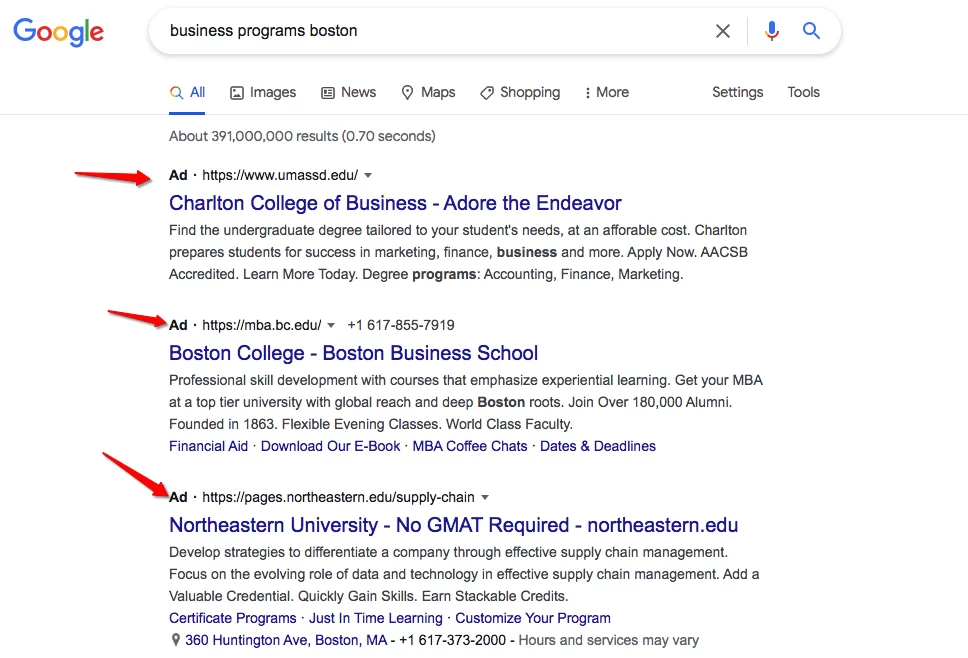In 2025, higher education marketing strategies should leverage the benefits of digital tools to expand their reach and stay ahead of the competition. The higher education sector is at a growing market worth $477.12 billion and is expected to reach 853.28 billion by 2030.
Players in this expanding market compete fiercely to attract prospective students. The Simpson-Scarborough research states that for every student enrolled, the typical educational institution spends $429 to $623 on marketing.
Recently, as technology has advanced, many educational programs have moved online using different marketing approaches to reach their audience. In this blog post, we’ll share some of the best higher education marketing strategies. I will also show some examples of implementing these strategies for great results.
Table of Contents
Importance of Marketing for Higher Education Institutions
Higher education institutions need a robust marketing strategy to increase visibility and maximize admission. They must focus on the diversification of the student and faculty enumeration.
When university or college marketing is done right, it reaches:
- More of the right kind of students
- Parents and individuals who influence students’ decisions
- Employees and well-qualified faculty
It can boost the higher education institution’s profile and student enrollment rates, increasing revenue.
Ways to Market Higher Education Institutions
Higher education marketing strategies can go about two ways:
- Through traditional marketing tactics, including:
- Print ads
- Radio ads
- TV ads
- Mails and handouts
- Campus visits and tours
- Development of certain department
- Through digital marketing tactics, including:
- Social media marketing (SMM)
- Content marketing
- Email marketing
- Search engine optimization (SEO)
- Search engine marketing (SEM)
- Paid ads
A good university marketing plan strikes the right balance between these two marketing approaches.
Read also: Who is a Manager? Roles and Responsibilities Defined
Enhance Your Email Marketing
Want to make your emails more impactful? Check out our beautiful, easy-to-customize HTML email templates. Designed to boost engagement, these templates from EngageBay will help your emails stand out. Just customize the images, headings, and CTAs for your brand, and hit send in a few minutes!
Higher Education Marketing Strategies for the Digital Age
Digital marketing is essential for higher education institutions to reach and engage with their target audience effectively. Here, we’ve explained 16 ways higher education marketing strategies that are proven to get results.
1. Generate qualified leads by publishing quality articles
Studies found that 70% of B2C marketers include content marketing in their marketing plan (source). Content marketing lets a brand establish a solid reputation and assists customers with decision-making.
Once colleges and universities produce content relevant to their audience’s search intent, content marketing becomes a valuable investment. Enhance your content marketing strategy by following these tips:
- Spend time researching the platforms where your intended audience will most likely consume content
- Carry out content optimization for all major search engines, not just Google
- Use social media to promote content to reach a broader audience
- Get a high-quality CMS tailored to educational institutions to manage omnichannel content
- Create content that consistently conveys your message and incorporates components of your branding
- Update old content regularly to avoid stagnancy
Example: University of California
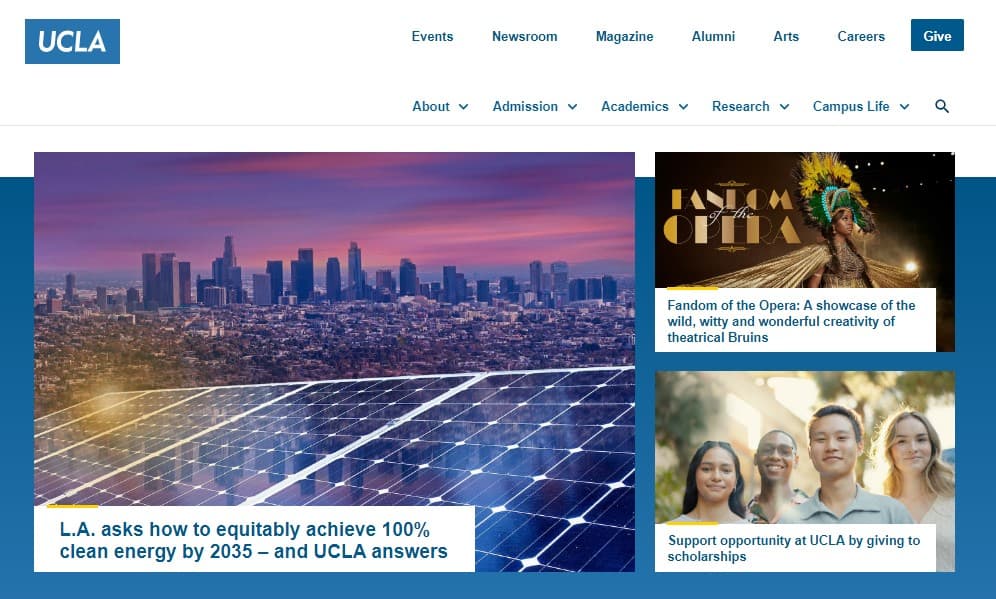
2. Enhance engagement with the transformative power of AI
Artificial intelligence (AI) has transformed marketing, like every other industry. AI significantly speeds up the content generation process, with 85.1% of users using it to write articles and create different forms of content.
Colleges and universities can also leverage AI to create engaging content catering to their target audience. It can help higher education institutions maintain their online presence and enhance engagement consistently.
Higher education marketing strategies can incorporate AI to amp up productivity by automating content for:
- Blogging
- Social media marketing
- Email marketing
- Live-chatting
For example, Harvard University uses AI to tailor content to its wide and varied audience by evaluating user interactions and preferences.

3. Optimize your social media presence for audience expansion
Social media platforms can be a great way to distribute content for increased reach, brand awareness, and relationship building. Higher education marketing strategies can include a social media marketing plan to:
- Provide information about the programs they offer
- Announce university events
- Share news and articles
- Promote their campus culture
- Share success stories of current and ex-students
- Create a network of their prospective and existing students, staff, and alumni
When it comes to the right social media platform to promote universities, consider the following:
- Snapchat, TikTok, and Instagram are popular among younger demographics – so, students.
- Facebook and LinkedIn are popular among the older group demographics – so, parents.
- Students and parents often use YouTube to understand processes like:
- Course registration
- Tuition payments
- Applications
- Filing FAFSA forms
- Other activities
Higher education institutions can incorporate different social media platforms for different targeting intentions to make the most of social media marketing.
Example: University of California.
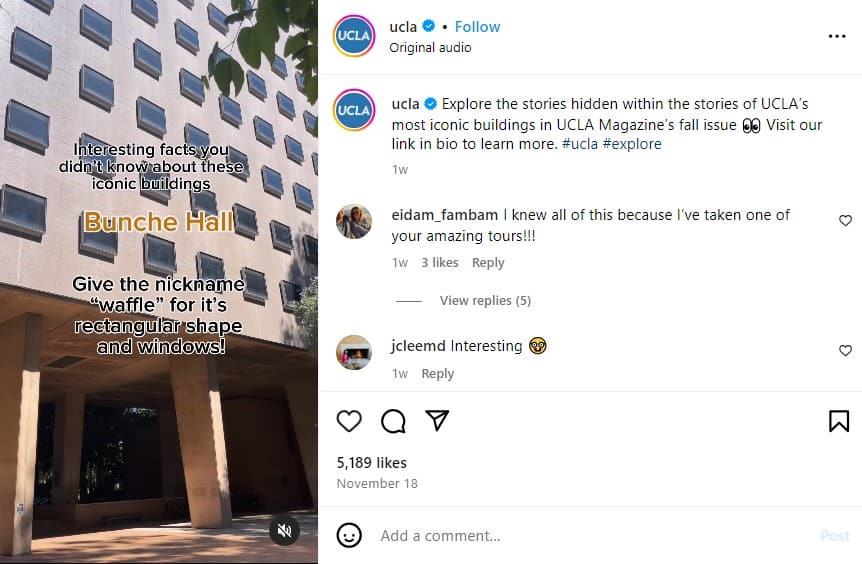
4. Share student stories to help prospects visualize their future
Word of mouth is among the most powerful ways to market student experiences at colleges and institutions. Many prospective students put much more weight on what current and past students say about the institution over its promotional content.
Sharing student journeys and success stories is an excellent way to show potential students that the institution can prepare them for a bright future. Their stories allow you to showcase the organization’s dedication to student achievements.
Here are some ideas for incorporating student experiences into higher education marketing strategies:
- Motivate current and past students to leave good evaluations on various review sites
- Share their stories via online profiles on the organization’s website and social media page
- Incorporate user-generated content (USG) by encouraging students to post about their experiences
Current students’ and alums’ stories remind prospects of why they should invest in being a part of your institution. It establishes the college or university as a place where students grow into people ready to make a difference.
Example: Product School
5. Make video content for more engagement
Statistics show that video is one of the most powerful digital marketing channels today, with 86% of marketers incorporating it into their strategy.
Students in their sophomore, junior, and senior years agree that college-related videos are helpful. Because of this, universities need to include it in their higher education marketing strategies.
Here’s how you can create and distribute video content for increased engagement:
- Post videos on social media and websites on different subjects
- Create long and short-form videos on college and university life
- Post videos for event promotional and results
- Create how-to videos on YouTube to guide students and parents in specific processes
- Share recorded tapes of campus events, such as sports and lectures
- Give access to live cams at certain locations so students can keep a check on what’s happening around the campus
- Create virtual tour videos to illustrate campus facilities
Example: University of California
6. Invest more in short-form videos
If a video is shorter than 90 seconds, over half of the viewers will watch it until the end (source). This is why a short-form video strategy must be a part of all higher education marketing strategies.
You can now embed short-form video content on almost all social media platforms. Using TikTok, higher education institutions may reach potential students with brief videos and make a big impact by increasing their exposure and building brand recognition.
Campus amenities influence 64% of students, having some sway over their enrollment decisions. However, due to COVID-19, many students depended on virtual campus tours to assess the campus amenities.
The trend continues as not all prospective students can visit campus after the pandemic. A video marketing strategy may address these needs with short-form videos for:
- Answers to frequently asked questions
- Short virtual tour guides
- Course program lists
- Specific on-campus resources
- Positive student experiences
Example: John Cabot University
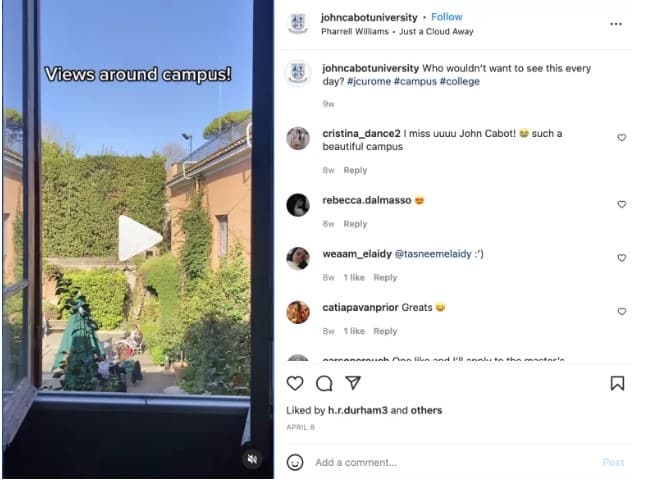
7. Live stream videos to let prospects attend university events virtually
You know the power of short-form videos by now. Let’s discuss a specific kind of long-format video that offers great potential.
YouTube is a popular platform to stream long-format content. It is also readily available to anyone:
- Prospects
- Current students
- Faculty
- Parents
- Alumni
It is a common tool for college and university marketing campaigns. However, did you know many colleges even use it to broadcast commencement, homecoming, and big sports events?
Research shows that 80% of consumers prefer live videos to blog posts, and spend 3X more time viewing live videos than recorded ones.
While short-form and other long-form content are popular means to distribute information and spread awareness, live-streaming videos build real connections with audiences. Live video streaming is also available on Facebook, TikTok, Snapchat, and Instagram.
The following are some of the reasons why higher education institutions find it valuable to incorporate live streaming in their video marketing strategy:
- Live broadcasting reduces physical barriers, allowing colleges and universities to reach more prospective students than before
- Prospects can notice details they would miss in more impersonal modes of communication, such as email or a phone call, which helps to establish trust
- Facilitates communication by providing means for users to interact with each other via a built-in chat and reaction features
Example: University of Waterloo
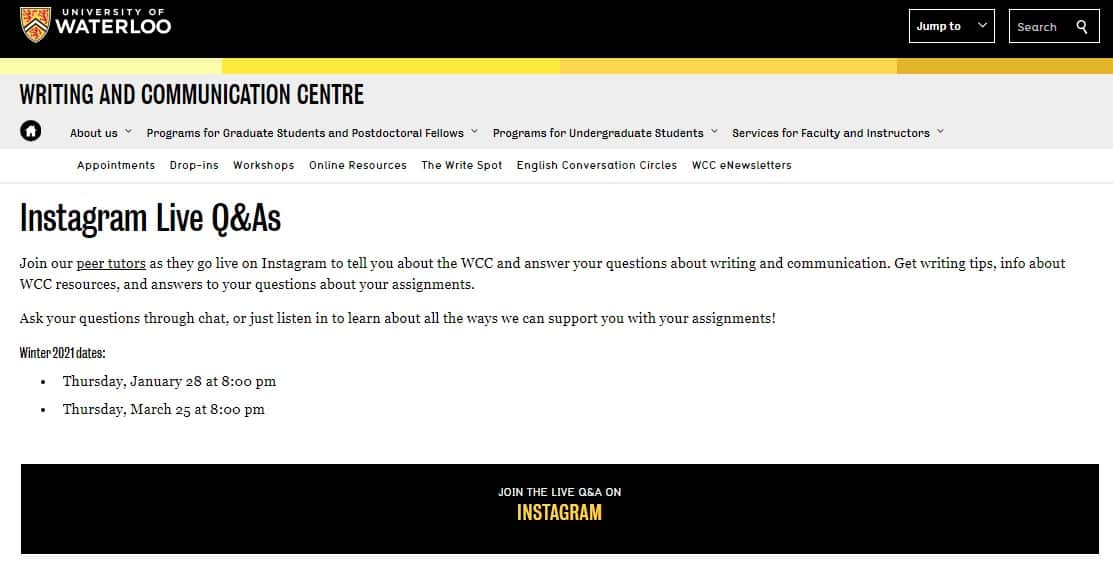
8. Boost social media reach with influencer marketing
Influencer marketing relies on endorsements and recommendations from prominent individuals. These individuals often have a large social following, who recognize them as experts in their field.
Higher education marketing strategies can reap the benefits of influencer marketing to increase their social media presence in the following ways:
- Get a boost by requesting an influencer for a one-time promotion
- Ask an influencer or brand ambassador to reshare the university’s content for more viewers
- Bring more attention to the organization’s social media pages by mentioning an established influencer
- Develop an ongoing partnership with influencers and ambassadors for continued promotional support to the institution
Students as brand ambassadors should be familiar to you. Current students and alums as brand ambassadors are common in marketing campaigns for higher education institutions.
You may begin with a brand ambassador program with an in-house strategy in these two ways:
- Find the most accomplished graduates from the institution and use them in marketing content to boost the institution’s reputation
- Get in touch with former students and urge them to support the college or university with endorsements on social media
Example: New York University
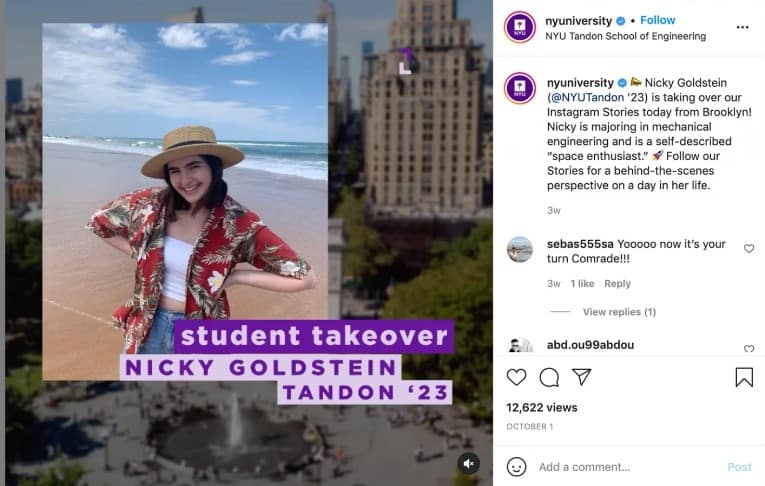
9. Invest in targeted digital advertising to boost conversions
Everyone in marketing knows the influence of Pay-Per-Click (PPC) ads in driving sales. Higher education marketing strategies can micro-target students with:
- Google ads
- Bing ads
- Social media ads
Ads show up when students make specific searches or search from certain locations. Higher educational institutions may also get better results by running ad campaigns to retarget site visitors interacting with their content. You can retarget visitors using Google’s remarketing lists for search ads.
A generic term like “MBA degree” might be costlier to rank for due to the high search volume and competition. In that case, a college may still obtain a good ROI by targeting individuals who search for it after visiting its website. These individuals are more likely to convert when offered additional content through ads.
Another option with RLSA is custom intent audiences. You may target users for certain keywords based on their search history, increasing the likelihood of conversions.
👉 Boost your marketing efforts with our email templates. Just customize and send!
10. Get web traffic with SEO content
You might be a social media marketing guru, but you can never undermine the importance of a business popping up on top of search engine result pages (SERP). SEO generates more than 1,000% more organic traffic than social media.
Higher education institutions need that, too. When a student searches for colleges or universities in a specific domain or program on Google, ranking in the top results gives:
- More visibility
- More authority
- More credibility
- More priority (as a result of the above three)
Search engine optimization (SEO) needs planning and long-term effort to build content that matches ranking criteria. For example, if you’re focusing on SEO, you might need to consider the following on-page optimization elements:
- Internal and external linking
- Keyword research
- Meta tags
- Descriptive URLs
- Structured content
- Mobile-friendly website
SEO won’t immediately make the university website rank higher in search results. However, SEO will build the website’s authority over time, which is crucial if you want more visibility to attract targeted visitors regularly.
Example: University of Pennsylvania

11. Drive more search traffic by optimizing for featured snippets
One of the most effective SEO approaches is to get highlighted in Google’s featured snippet. Featured snippets, part of Google’s algorithm, highlight the most relevant and high-quality content from websites at the top of the search results page.
Marketers call snippets “the rank 0.” This is because Google puts them before the first-ranking website. Achieving a highlighted snippet box ranking for your website can:
- Give you maximum visibility
- Increase organic traffic
- Boost your lead generation
You may optimize your website content to rank for Google’s featured snippets with:
- Clear headings: Organize content with headings for clarity.
- Question keywords: Include question-based keywords in your web pages.
- Concise answers: Keep answers brief and focused on the query.
- Schema Markup: Implement schema for Google to have better context.
Google utilizes page titles to choose which websites to include in the snippet. Therefore, your page titles must include relevant information. You will have less chance of getting featured if the title is not directly relevant to the search query. If the content does not have a distinct title for SEO, you can optimize the subheadings for the keyphrases.

12. Route traffic from other websites with Google display ads
Ads on Google reach more than 90% of the world’s internet users. Advertisers may use Google ads to present advertisements on other websites to drive traffic.
Marketers may create ads using Google Display Network with:
- A variety of formats
- Different headlines
- Dynamic content
- Different images
The network will automatically present an appropriate ad version based on the user’s platform or device.
Google found that marketers get 10% higher conversions per action (CPA) when responsive display ads include several headlines, descriptions, and pictures.
With Google’s digital display ads, colleges and universities may reach a wider audience by targeting them based on their search history. Google adverts allow higher education institutions to place banner and image adverts on over two million websites in Google’s Display Network.
Example: University of Kent
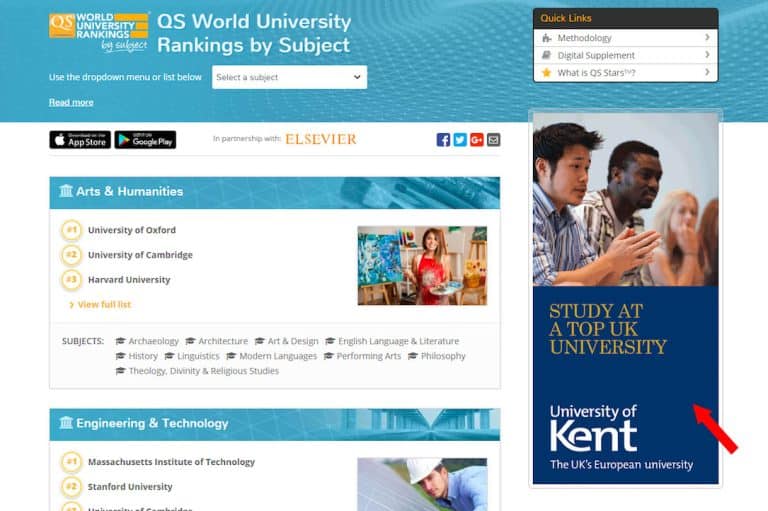
13. Use current student data to target a lookalike audience
Any higher education institution’s current student data is a marketing treasure trove. Higher education marketing strategies can leverage it to create campaigns to attract a “lookalike” audience.
Lookalike audience is segmenting target audience based on matching demographics and interests to the current students. Using current students’ data to target lookalike audiences can offer the following benefits:
- Colleges and universities will focus on the target market that is more likely to engage and convert
- What your organization has to offer is more likely to be an interest for these lookalike students
- Students who do enroll are more likely to meet your organization’s criteria and requirements
Using the data of your current students lets you fine-tune the admissions process and boost the percentage of leads that become paying students (conversion rate).
14. Personalize and automate your email marketing campaigns
Email marketing is the most preferred method in higher education marketing strategies. While many promotional emails fail to get the prospect’s attention, some even landing in the spam folder, people often take notice of personalized emails. Therefore, if used correctly, email marketing becomes an invaluable asset to higher education marketing strategies.
To deliver personalized content, take into account the following tips:
- Segment the contact list based on the potential students’ application stage
- Tailor the material according to the segment group’s interest
- Use email templates that encourage readers to take certain action
- Take measures to dodge spam filters
- Use tools to respond promptly with personalization using existing data
To boost college enrolment, incorporate email marketing automation tools to deliver more targeted and personalized emails to prospects. They automate the delivery of the right message at the right time using current data on the target audience.
Example: Charles Sturt University
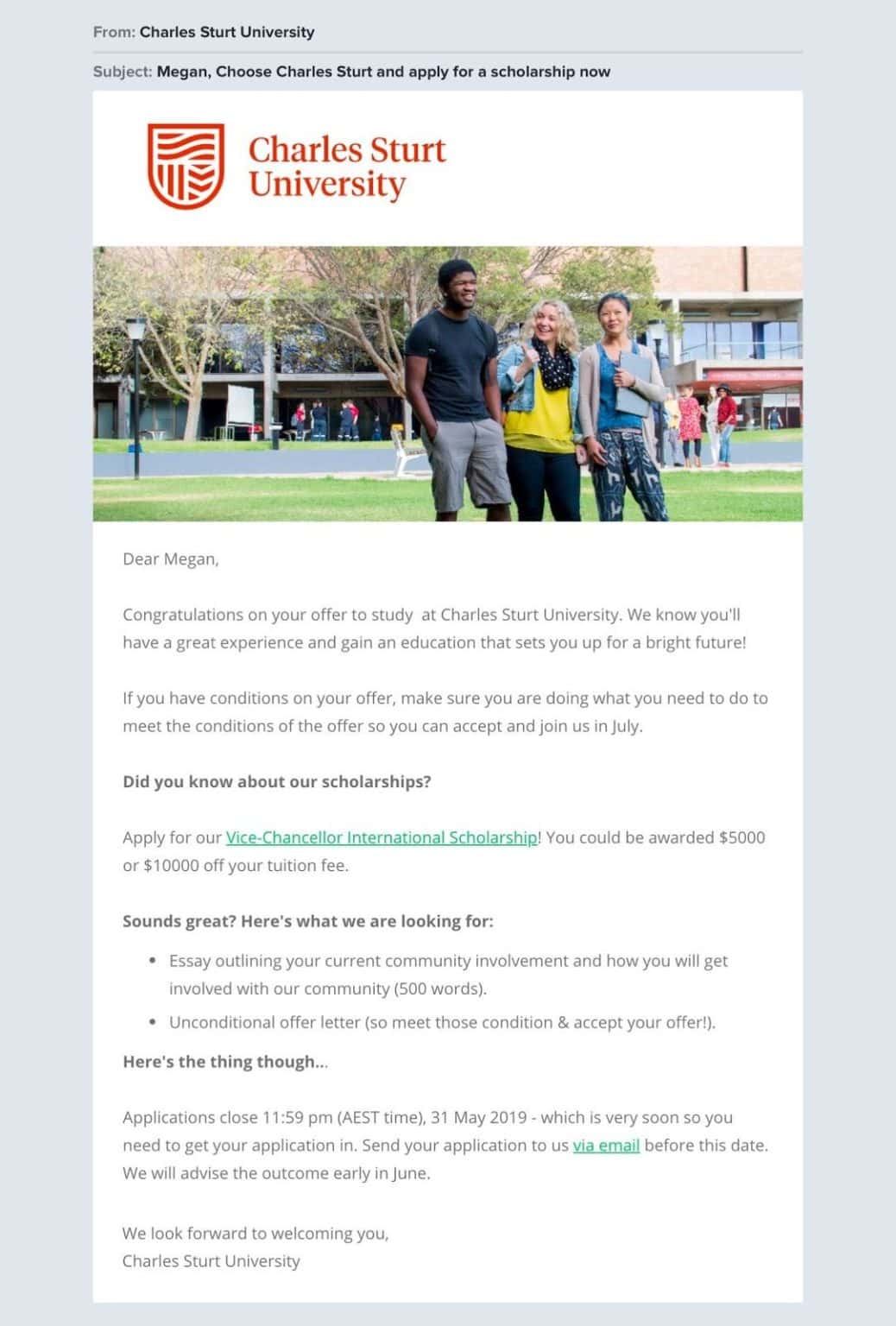
15. Track goals and leverage advanced analytics to make informed decisions
While Google Analytics delivers a wealth of data influencing essential marketing choices, it may not suffice. By establishing targets and metrics to monitor more targeted interactions with your website and landing pages, you may get valuable insights like:
- Find out what parts of your site are doing well and what parts may require some work
- Find out what students do when they visit your site
- Make informed decisions using your data for pay-per-click (PPC) and other sponsored ads targeting certain audience groups
Such information is far more than what Google Analytics gives you by default. Different tools in customer relationship management (CRM) and customer data platform (CDP) categories provide the capability to integrate first-party data from various sources, creating a comprehensive profile for each customer. They may pave the way for data-driven marketing automation for:
- Highly tailored website ads
- Content personalization
- Personalization of user experiences
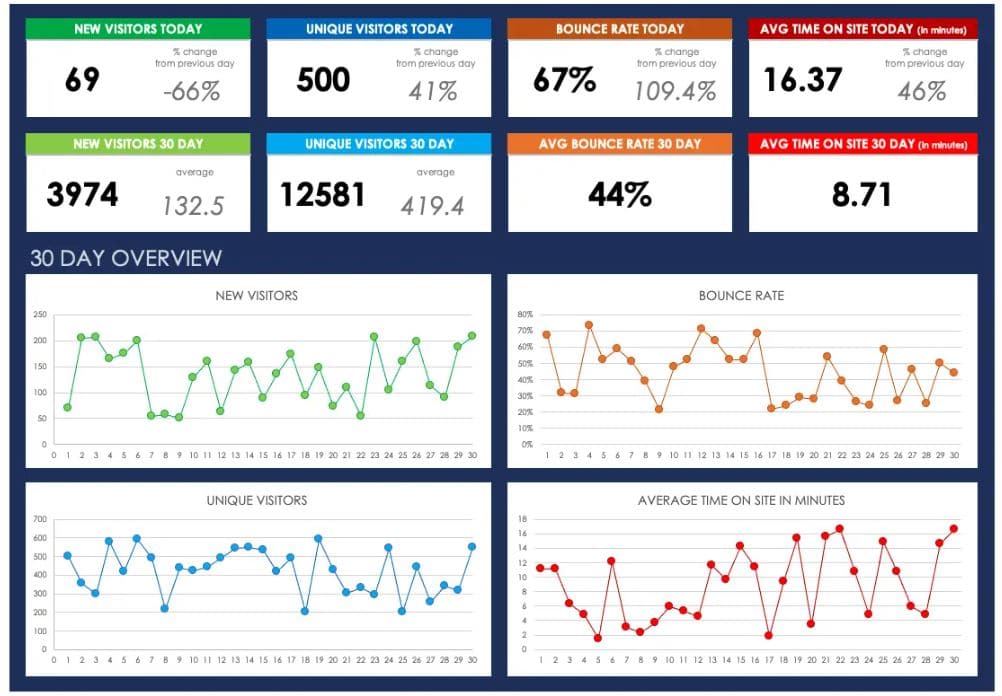
16. Chatbot integration for quick student query resolution
The worldwide chatbot marketing income will hit $83.4 million this year. AI-powered chatbots automate real-time live discussions to respond immediately to customer queries. With ongoing development, they can conduct entire conversations 69% of the time.
Conversational marketing places a premium on time. Therefore, marketers leverage chatbots on various channels like websites and social media to respond to client inquiries faster. They may also provide exceptional student support for higher education institutions with the automation of human response and the immediate provision of vital information to students.
Many universities are embracing chatbots to improve their higher education marketing strategies and help prospects rapidly to encourage speedy conversions.
Example: Georgia State University
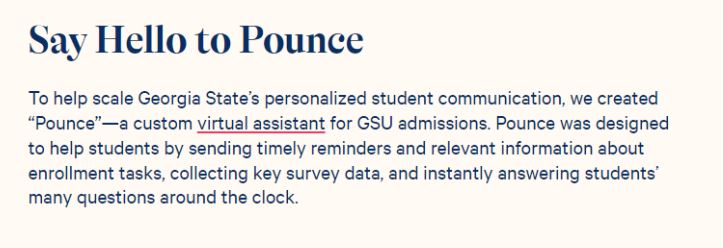
Trends and Best Practices for Higher Education Marketing Strategies
Developing effective marketing strategies for higher education involves understanding current trends and adopting best practices to engage with prospective students, parents, and other stakeholders. Here are some key trends and best practices to keep in mind for higher education marketing.
Transition to Google Analytics 4
Google announced its transition from Universal Analytics to Google Analytics 4 in March 2020. Google Analytics 4 is not a cosmetic upgrade. It revamps how:
- Google tracks site activity
- How websites report analytics data
So, if you are still on the older version, it’s time to change.
CMS for higher education institutions
Using a content management system tailored to higher education is essential. It will help detect and address issues such as:
- Outdated content
- Faulty coding
- Inconsistency in brand voice
Changing landscape of social media
The social media landscape is ever-changing. A lot of advertisers pulled out of Twitter (now X) following core changes made by Elon Musk, and he hasn’t responded well. Many countries have either banned TikTok or have made plans to restrict its usage.
Review your social media marketing strategy considering the latest state of affairs in the social media world — it is ever full of surprises.
Rise of AI and ChatGPT in content marketing
ChatGPT is already influencing the content game of higher education marketing. In general, though, it’s not a good idea to use AI to generate all your content. However, AI tools can expedite marketing content creation in the following ways:
- Helping with keyword research
- Repurposing content
- Creating outlines
- Ideation
Responsive ads for campaigns
Here are some tips to get the most out of your ad campaigns:
- Try using multiple headlines, descriptions, pictures, and CTAs to make your ads responsive
- Direct prospects to different landing pages with CTAs suited to their search interest
- Track visitor behavior on your website, which can tell you what to place where
Multimedia visual content
Good aesthetics in visual content are a must for appealing to the Gen Z audience. Text-heavy content doesn’t sit well with this generation. Instead, go for more visual elements in your marketing content, such as:
- Infographics
- Images
- Short and long-format videos
- GIFs
Content may be the king, but personalization is everything
Your website and content deliver personalized experiences to your visitors, meaning:
- A mobile-friendly website that works on all platforms and devices
- Content tailored to the users’ preferences
Leverage digital tools to deliver personalized experiences to website visitors like:
- Prospective students
- Parents
- Professors
- Counselors
Parents are deciding factors, too
Parents are often a huge determinant in students’ college admissions. So, while targeting students is necessary, you need to target parents, too. Note that the methods to target these two demographics are quite different.
- Parents use older social media platforms such as Facebook
- They are more concerned about things such as security and future scope
Traditional marketing is still here to stay
As the use of the internet increases, digital marketing is undoubtedly gaining significant influence in users’ decision-making. However, do not forget conventional marketing media such as:
- Billboard ads
- Community events
- Radio ads
- TV ads
- Mails and handouts
Statistics in content attract prospects
Words are great, but numbers also matter when it comes to showing the success of your higher education institution. Use statistics to show your university’s achievements and the success stories of previous student batches.
Interactive webinars work well
Interactive webinars are great for attracting more students in the later decision-making stages. Such virtual events can:
- Help answer many of their questions
- Give prospective students a taste of what it is like to be at your university
Read also: 18 Marketing Strategies & 10 Examples From Top Brands
Conclusion
In conclusion, it is important to develop quality content that gives prospects enough material to make informed decisions.
Make use of multimedia content. Double down on SEO for long-term growth. Contact influencers and invest in targeted digital advertising for an immediate visibility boost.
If you were wondering where to start, I hope this blog gives you clarity. All the best!
FAQ
What social platforms can higher education institutions use?
Use different platforms to target different demographics of your target audience. For example, Snapchat and TikTok are for young audiences. On the other hand, Facebook, Twitter, and LinkedIn are for parents.
How do you develop higher education marketing strategies?
To develop a robust higher education marketing strategy, you need to:
- Look at your strengths
- Find out what students and their parents view as important
- Determine what platforms you want to leverage
- Decide on your short-term and long-term marketing goals
How can higher education institutions use influencer marketing?
Higher education institutions can reach out to alumni to promote their alma mater. They can also invite education influencers to visit their campus and promote the university on social media, preferably with short-form videos and appropriate hashtags.
👉 Create and launch successful email campaigns with EngageBay’s all-in-one solution and stunning, free email templates. Don’t miss out — get started today!


